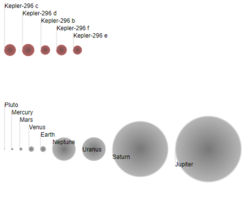Astronomy:Kepler-296
From HandWiki
Short description: Star in the constellation Draco
| Observation data Equinox J2000.0]] (ICRS) | |
|---|---|
| Constellation | Draco |
| Right ascension | 19h 06m 09.60253s[1] |
| Declination | +49° 26′ 14.3969″[1] |
| Characteristics | |
| Spectral type | K7 V + M1 V[2] |
| Astrometry | |
| Proper motion (μ) | RA: 2.635[1] mas/yr Dec.: −16.375[1] mas/yr |
| Parallax (π) | 4.5538 ± 0.5562[1] mas |
| Distance | approx. 720 ly (approx. 220 pc) |
| Details[3] | |
| Kepler-296 A | |
| Mass | 0.498+0.067 −0.087 M☉ |
| Radius | 0.480+0.066 −0.087 R☉ |
| Surface gravity (log g) | 4.774+0.091 −0.059 cgs |
| Temperature | 3740±130 K |
| Metallicity [Fe/H] | −0.08+0.28 −0.30 dex |
| Kepler-296 B | |
| Mass | 0.326+0.070 −0.079 M☉ |
| Radius | 0.322+0.060 −0.068 R☉ |
| Surface gravity (log g) | 4.993+0.087 −0.063 cgs |
| Temperature | 3440±75 K |
| Other designations | |
| Database references | |
| SIMBAD | data |
| KIC | data |
Kepler-296 is a binary star system[3] in the constellation Draco. The primary star appears to be a late K-type main-sequence star, while the secondary is a red dwarf.[2]
Planetary system

The following plot shows the approximate sizes of the planets in this system compared to planets in the Solar System.[5]
Five exoplanets have been detected around the system; all are believed to be orbiting the primary star rather than its dimmer companion.[3] Two planets in particular, Kepler-296e and Kepler-296f, are likely located in the habitable zone.[3] For the planetary system to remain stable, no additional giant planets can be located up to orbital radius 10.1 AU.[6]
| Companion (in order from star) |
Mass | Semimajor axis (AU) |
Orbital period (days) |
Eccentricity | Inclination | Radius |
|---|---|---|---|---|---|---|
| b | — | 0.079 | 10.864384 | 0.33 | — | 1.61 R⊕ |
| c | — | 0.0521 | 5.8416366 | 0.33 | — | 2.00 R⊕ |
| d | — | 0.118 | 19.850291 | 0.33 | — | 2.09 R⊕ |
| e | — | 0.169 | 34.14211 | 0.33 | — | 1.53 R⊕ |
| f | — | 0.255 | 63.33627 | 0.33 | — | 1.80 R⊕ |
See also
References
- ↑ 1.0 1.1 1.2 1.3 Vallenari, A. et al. (2022). "Gaia Data Release 3. Summary of the content and survey properties". Astronomy & Astrophysics. doi:10.1051/0004-6361/202243940 Gaia DR3 record for this source at VizieR.
- ↑ 2.0 2.1 Lissauer, Jack J; Marcy, Geoffrey W; Bryson, Stephen T; Rowe, Jason F; Jontof-Hutter, Daniel; Agol, Eric; Borucki, William J; Carter, Joshua A et al. (2014). "Validation Ofkepler's Multiple Planet Candidates. Ii. Refined Statistical Framework and Descriptions of Systems of Special Interest". The Astrophysical Journal 784 (1): 44. doi:10.1088/0004-637X/784/1/44. Bibcode: 2014ApJ...784...44L.
- ↑ 3.0 3.1 3.2 3.3 3.4 Barclay, Thomas; Quintana, Elisa V; Adams, Fred C; Ciardi, David R; Huber, Daniel; Foreman-Mackey, Daniel; Montet, Benjamin T; Caldwell, Douglas (2015). "The Five Planets in the Kepler-296 Binary System All Orbit the Primary: A Statistical and Analytical Analysis". The Astrophysical Journal 809 (1): 7. doi:10.1088/0004-637X/809/1/7. Bibcode: 2015ApJ...809....7B.
- ↑ "Kepler-296". SIMBAD. Centre de données astronomiques de Strasbourg. http://simbad.u-strasbg.fr/simbad/sim-basic?Ident=Kepler-296.
- ↑ "Open Exoplanet Catalogue - Kepler-296 b". http://www.openexoplanetcatalogue.com/planet/Kepler-296%20b/.
- ↑ Becker, Juliette C.; Adams, Fred C. (2017), "Effects of Unseen Additional Planetary Perturbers on Compact Extrasolar Planetary Systems", Monthly Notices of the Royal Astronomical Society 468 (1): 549–563, doi:10.1093/mnras/stx461, Bibcode: 2017MNRAS.468..549B
External links
 |

